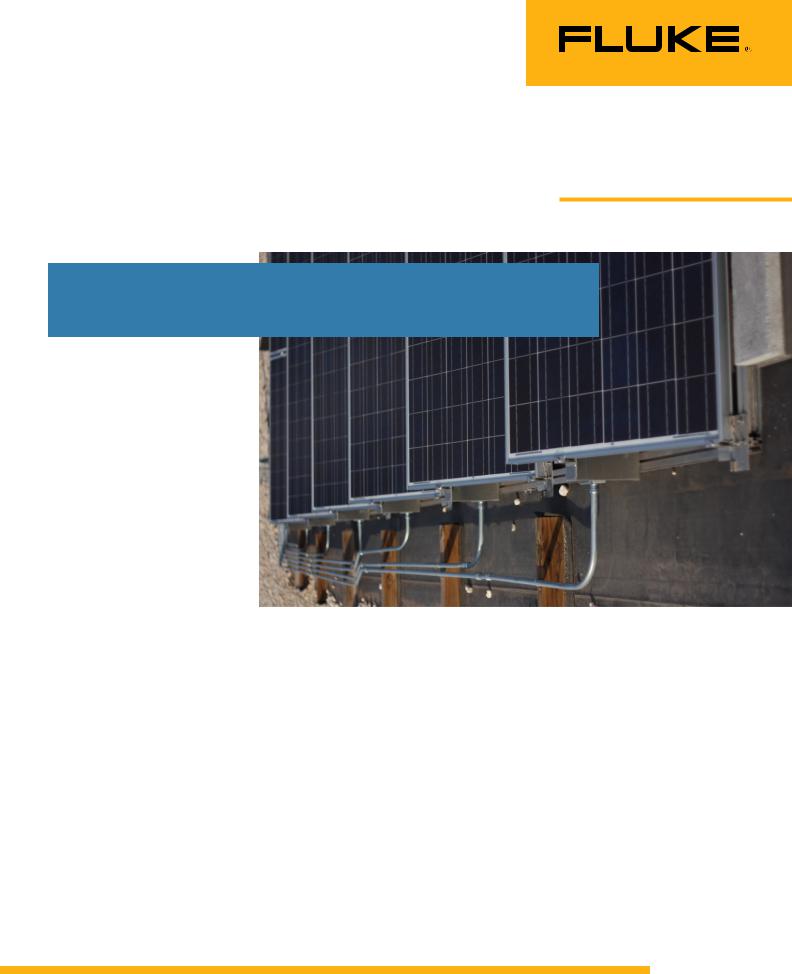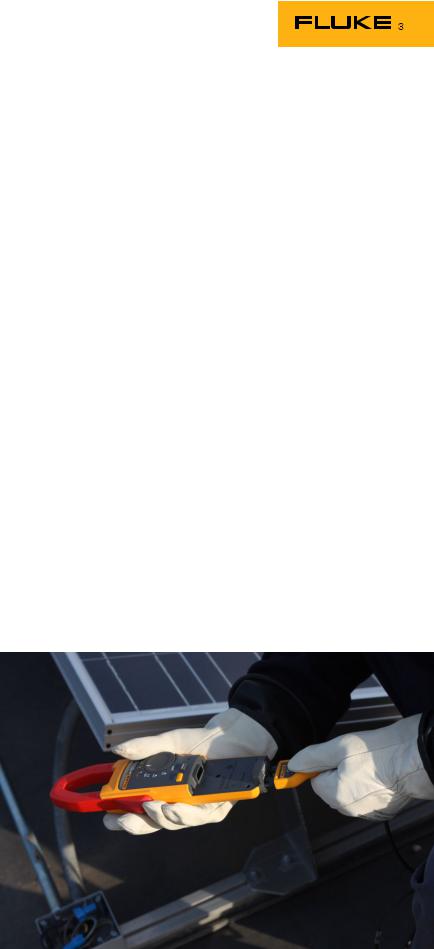Fluke 381 Service Guide

Troubleshooting photovoltaic systems: three typical problems
Application Note
By Ron Auvil
With the push to energy independence and renewable energy sources, HVAC technicians need to know how to troubleshoot photovoltaic systems
With the energy situation and problems in the last few years has come a major effort to increase
the amount of energy from renewable resources. State and federal government policies in many areas mandate increased use
of solar power. An HVAC technician who is servicing other equipment in the building might encounter solar power systems.
Because the concepts and arrangements of these systems are new to HVAC technicians, a short overview of the systems and components is in order.
Photovoltaic systems convert sunlight (photo) into electrical power (voltaic). The sunlight that strikes the semiconductor material in the individual cells causes electrons to move through a wire. The electricity gener-
ated by photovoltaic systems can be used to run a range of equipment, from domestic appliances to commercial production equipment.
There are a number of variables in a PV system, but ordinarily the PV array is mounted on a roof that faces the south as much as possible. Obstructions are avoided. Note
This electrical conduit connects a series of solar cell arrays.
that less power will be generated in the winter than the summer due to the shorter days. Also, maximum power will be generated at midday rather than in the morning or evening.
As part of the PV installation, some facilities provide a real-time computer display that shows the amount of energy produced by the PV display, the dollars saved, and the amount of fossil fuel usage avoided. It is great to know that facilities are increasingly leading the way to energy independence and lowering the amount of pollutants released into the atmosphere!
The electricity generated by a PV system may be used immediately by that facility, stored, or
in some cases sold back to the local electric utility.
It is only natural for facilities that have PV systems installed to expect HVAC technicians to at least know the basics. As these systems become more commonplace we may be expected to perform some basic troubleshooting of them.
Components of a PV system
PV systems consist of the following general components:
Individual cells. An individual cell is a small part of a PV system. A cell consists of the semiconductor material, a support structure, and a transparent material that allows the
F r o m t h e F l u k e D i g i t a l L i b r a r y @ w w w . f l u k e . c o m / l i b r a r y

sunlight to strike the semiconductor material. The cell must be physically tough as it is exposed to the weather. The transparent material that covers the cell also must be stain and dirt resistant. Each individual cell produces only a few watts of electricity.
Modules and arrays. A module consists of a number of cells connected together side by side. Modules may be in either series or parallel, as needed to obtain the desired voltage and current. Since each individual cell only produces
a small amount of electricity large numbers of them must be joined together to get significant amounts of electricity. As may be imagined, these modules can become quite large and limited by the size of the roof dedicated to their use. Modules joined together are then called arrays. Wiring connects the individual cells together to form these arrays. The arrays are then wired together to a central point.
Concentrators and combiners. A concentrator or combiner is a central wiring point for the cells and modules. It represents the aggregate power output
of the entire solar array. Even though the output of each solar cell is small, at the point where multiple modules are connected many amps of current are present. Metering and conditioning of the power may also take place at the concentrator. The concentrator is then connected to either electrical storage or an inverter. Storage may consist of a large number of batteries.
Inverters. The power produced by a PV system is dc. The vast majority of loads in a building are ac. An inverter is used to convert the dc power created by the modules into usable ac power. The output of the inverter may also be connected to the local utility so that any excess unused power is put back into the grid and purchased by the local utility to be used by other customers. Metering and power monitoring equipment are installed here as well.
Since there are really few components in a PV system there are not many things to go wrong. As mentioned previously the major components are the cells, modules, arrays, concentrator/combiner and inverter. The PV system in the building may be providing power to
HVAC equipment or affecting the power quality of the building. This means that HVAC technicians may need some basic troubleshooting skills. (After all, we are expected to know how to work on everything on the roof anyway, right?)
Three typical PV troubleshooting situations
In the examples below, the person doing the troubleshooting is taking advantage of the features of the new Fluke 381 Remote Display True-rms Clamp Meter with iFlex™. While you can use a true-rms ac/dc clamp meter with voltage capabilities for most of the work, we used the Fluke 381 because
of its wireless feature (remote readout and display), and the iFlex™ flexible current probe. The iFlex™ probe is absolutely vital for troubleshooting these photovoltaic problems. Since large numbers of wires connect each module and array to the
A technician attaches the iFlex™ flexible current probe of a 381 Clamp Meter as he prepares to troubleshoot a photovoltaic system.
2 Fluke Corporation Troubleshooting photovoltaic systems: three typical problems
concentrator box, the junction boxes are stuffed with individual wires. The iFlex™ probe makes the measurement of the individual module wires MUCH easier, thus saving time and increased accuracy.
Troubleshooting Problem #1: Cell/Module/Array Problem
As with any troubleshooting call, try to get as much information from the customer as possible. Try to find out when the problem occurred and when the last time the PV system operated normally. Get as much information, such as prints, outputs, and wiring diagrams, as possible.
A good place to start is to check the output of the entire system at the metering system or at the inverter. Prior to getting on the roof, check and record the inverter’s input voltage and current level from the array. If the entire PV system is down and not producing power it may be an inverter problem. If the PV system is operating at a reduced power output the problem may be one of the arrays or modules. You will have to trace out the individual branch wiring backward from the concentrator. Again, the iFlex™ makes this an easier job than it would be otherwise.
